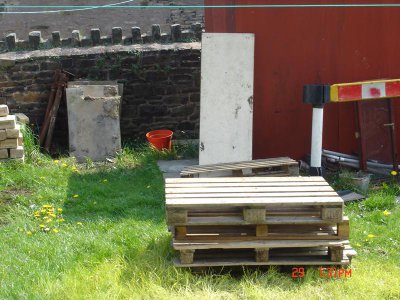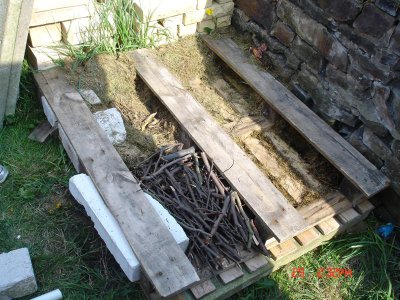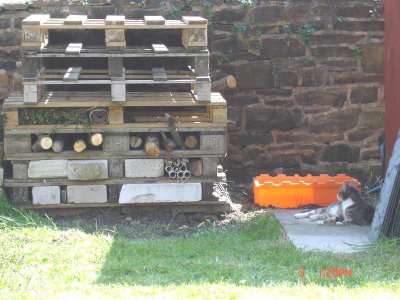Building an invertebrate habitat
Attracting wildlife to your garden can have huge benefits and save you money!
Slugs: Frogs and hedgehogs eat them and their eggs (laid under your soil) - a small pond close by to your habitat can sustain them and help in the constant battle against the slugs that eat your veg and plants.
Butterflies: Allowing things to overgrow a bit, seems to attract more wildlife into the garden.
Midgies: From the little pond, midgies swim around then leave the pond and fly around the garden.
Why would I want to provide a haven for these insects? There's method in the madness, we have a family of bats that live over the back, as the midgies rise as soon as dusk falls, the bats swoop down and eat them! (Don't even bother trying to photograph them, I have been trying to catch them on camera for years, not a single success story to show for it yet hehe)
The link I have included in this post (at the top) has laid out instructions for building your own.
Find a quiet corner of your garden, put down a few paving stones or flags, to provide a solid base for your habitat, turn the bottom pallet upside down and place the next pallet the right way round on top of it, this leaves a big enough space for hedgehogs to get in.
I use my habitat to get rid of grass cuttings and branches I chop off from the neighbours over hanging bushes, this provides great nesting material for the local birds, of which we have many here in Lancashire.
Kestrels, hawks, starlings, etc are common here. We have also seen blackbirds returning to feed, after years of not having them around because of building work dug up most of the natural landscape to the rear of our garden. If you provide materials and foods for them they will come back to any area.
We have even had a rare pair of yellow wagtails feeding.
Once your habitat is in place, don't expect instant results!
It takes a bit of time for animals to find it. In our very small pond that I built alongside the habitat (It is a simple large tub half buried in the ground with pebbles placed in the bottom and around the edge of it) we had to bring in frogspawn, the tadpoles seemed to thrive on it, still swimming around as late as November!
If frogs return to it, only time will tell, come next spring we shall find out!
So far we have had just one grey squirrel burying food around it, but it seems to like it as it provides cover for it from predators like the local cats.
Have fun with your habitat and just leave it be, let it develop its own wildlife as it surely will. Local wildlife we all saw as kids is taken for granted, but the block paving and tarmac revolution has not wiped wildlife out, but forced it to move on to other areas, building a simple habitat, we have found, gives the local wildlife a place to come back to and provides a means of existing alongside building mad Britain.
Bird feeding - try pomegranate
Heavy snow where we live today, yesterday in the area of the garden where I put the old chip pan lard with nuts in out, we had 3 old pomegranates, which we cut up into pieces and put out "just in case" the birds would like it.
Blackbirds went straight for the old lard with nuts in it (a breeding couple we have back in our area after they disappeared for years) but the starlings loved the pomegranate!
They tore it to shreds, especially the young birds, it looks like an old carcass lying in the snow, red everywhere, but they keep coming back for more.
Always good to see not only the local wildlife thriving but a food source I didn't think the birds would take to.
Don't forget, when putting out food for birds, positioning is key. Leave food out in the middle of the garden so the birds have a fighting chance should a neighbourhood cat come along, less cover = more time for the birds to eat safely!
Slugs - how do they know?
One of the most common pests in the garden, is the slug.
Slugs are very effective at surviving, yet we know so little about them apart from putting blue slug pellets down will kill them but damage the wildlife that feeds on them.
What we know:
- they hate gravel, sand, etc. course substances that get into their slime, they avoid
- you cannot drown a slug. I tried once, after ten minutes underwater, they had climbed out of the small pond we have and were back on their way to chomp on our veggies again
- they dislike the sun, heat, dryness
What I don't know about:
- how do they know the difference between vegetables and weeds?
- no matter how far away you throw them, they keep coming back
- apart from hedgehogs, who are their predators?
- Digging your soil over in winter, helps the frost kill their eggs, laid just under the top of the soil
As the old addage goes, "know your enemy" - any tips/information you can post will be gratefully received.
Wildlife on your street
Standing on the doorstep (having a smoke outside because of our new baby) as I have done so often during the four sleepless weeks we have had here, I never realised how much wildlife is right here in front of me.
We have more than 50 starlings, drifting from each TV aerial, waiting for the neighbourhood cats to vanish so they can swoop down on the new bird table, set up in the garden directly opposite our house.
Watching them are a pair of black headed gulls? that are not interested in the bread and nuts put out, but watching for where the food is being taken so they can raid the nest and eat the young of the starlings.
To the back of our house stands the last remains of an old cotton mill, with its huge mill chimney (still in working order) where pigeons like to hang out, it is not uncommon for a kestrel or hawk to swoop to feed on the young birds, who appear totally oblivious to the dangers around them.
During my nightly cigarettes, I have witnessed a female hedgehog and her young pass my gate and wonder down the street. The few resident garages, on a small plot, which are about 6 doors down from our house, often has a young fox snooping around and casually walking up the street towards the main road running parallel to our street.
In the back garden we have seen a yellow wagtail (which is quite rare I am told?) this summer and regularly have finches, blue tits and the good old robin visiting us throughout the year.
In late summer evenings, we have a family of bats swooping to feed on the midgies that are everywhere. They used to live in the old mill to the back of us, it was thought that the new housing development built around the old mill in the last couple of years, which took away trees and a stream that was there would damage the local wildlife, but as more and more people on our street plant trees, shrubs and flowers, the local wildlife hasn't decreased, but increased!
Our local wildlife has evolved and found new ways to increase their numbers and feed, mother nature is a powerful thing ;)
Chimes in the garden?
What is the fascination with these?
They make noise all night long in the breeze, yet the people who put them in their gardens, normally have double glazing, so they cannot hear them?
Are they used for scaring off vermin or the local cats?
What is their purpose?

















 03/01/10 03:13:49 pm,
03/01/10 03:13:49 pm, 
Recent Comments